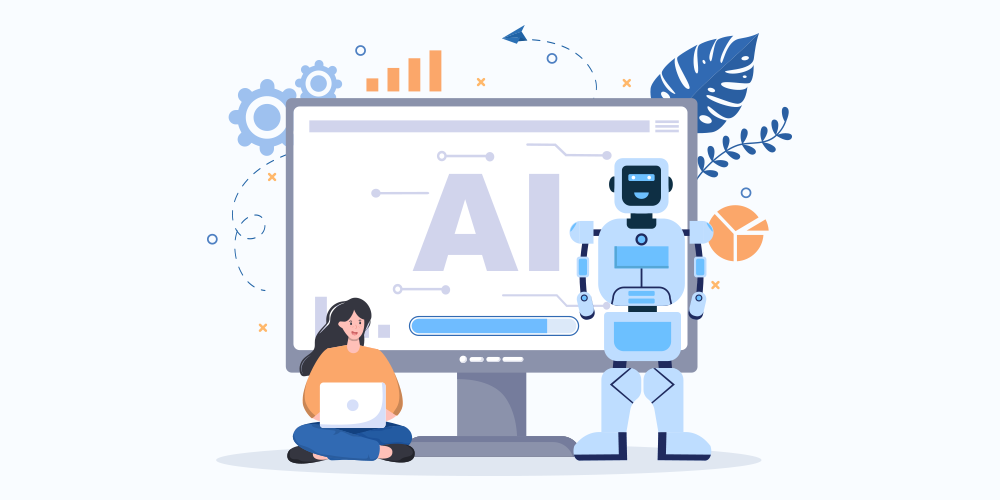Exploring the Future of Artificial Intelligence in Education
- admin
- 2023-05-03
- 11 min read

As the world becomes more reliant on technology, industries are looking for ways to incorporate artificial intelligence (AI) into their operations. The education sector is no exception, with many schools and universities already using AI-driven tools to enhance learning outcomes. However, the potential for AI in education goes far beyond the current state of implementation. In this article, we will explore the current state of AI in education, the potential for AI to transform the education sector, challenges and concerns, case studies, and preparing for an AI-driven future of education.
The Current State of AI in Education
Contents
- The Current State of AI in Education
- AI-driven personalized learning
- Intelligent tutoring systems
- Automating administrative tasks
- The Potential of AI in Transforming Education
- Enhancing Student Engagement
- Improving Accessibility for Students with Disabilities
- Supporting Teacher Development and Decision-making
- Challenges and Concerns for AI in Education
- Case Studies of AI in Education
- Preparing for the AI-Driven Future of Education
- Conclusion
The use of AI in education is not a new concept, but it is still in the early stages of implementation. AI-driven tools are being used primarily for automating administrative tasks, such as grading papers and generating student progress reports. However, there is a growing trend of AI-driven personalized learning , which tailors the learning experience to each individual student’s needs.
AI-driven personalized learning
Personalized learning is the practice of tailoring the learning experience to fit the needs of each individual student. AI-driven personalized learning takes this a step further by automating the process of identifying each student’s unique learning needs. By analyzing data from student performance, an AI system can create a tailor-made learning plan for each student, allowing them to progress at their own pace.
AI-driven personalized learning has the potential to ensure that no student is left behind or held back by a one-size-fits-all approach to education. With the help of AI, teachers can provide more personalized instruction to each student, which can lead to better academic outcomes and increased student engagement. However, there are concerns about the data privacy and security of such systems, as well as the potential for increased inequality if some students are unable to access AI-driven learning systems.
Despite these concerns, AI-driven personalized learning is gaining momentum. Many schools and universities are investing in AI-driven learning systems to improve student outcomes and provide a more customized learning experience.
Intelligent tutoring systems
Another example of AI in education is the use of intelligent tutoring systems, which provide personalized feedback and guidance to students. These systems can diagnose a student’s strengths and weaknesses and adapt their teaching style to fit the student’s needs. The goal is to provide students with the support they need to achieve their best possible results while minimizing frustration and confusion.
Intelligent tutoring systems have been shown to be effective in improving student outcomes in specific subject areas, such as mathematics and science. However, the technology is still in its early stages, and more research is needed to determine its effectiveness across a wider range of subjects. As the technology advances and becomes more sophisticated, it has the potential to revolutionize the way students learn and interact with educational content.
Automating administrative tasks
AI is being used to automate many administrative tasks in education, such as grading and processing student data. This allows teachers and administrators to spend more time focusing on other aspects of education, such as developing lesson plans and providing more personalized instruction.
The potential benefits of AI in administrative tasks are vast. By automating time-consuming tasks, teachers and administrators can devote more time and energy to providing a better educational experience for their students. However, there are concerns about data privacy and security. With sensitive information being gathered by AI systems, it is essential to ensure that data is kept secure and confidential. Schools and universities must take steps to safeguard student data and ensure that it is only used for legitimate educational purposes.
In conclusion, AI has the potential to revolutionize education by providing personalized learning experiences, improving student outcomes, and automating administrative tasks. However, it is important to address concerns about data privacy and security and ensure that all students have access to these new technologies. As AI continues to advance, it will be exciting to see how it can be used to enhance the educational experience for students around the world.
The Potential of AI in Transforming Education
Artificial Intelligence (AI) has been a buzzword in the world of technology for the past few years. It has been used in various industries, including healthcare, finance, and transportation, to name a few. However, the education sector has also started to recognize the potential of AI in revolutionizing the way students learn and teachers teach.
While AI is already being used in education, its true potential lies in the ability to transform the entire education sector. Here are three ways AI could enhance education:
Enhancing Student Engagement
One of the biggest challenges in education is keeping students engaged in the learning process. AI has the potential to make learning more engaging and interactive. For example, virtual reality and AI-driven simulations can provide students with immersive learning experiences that mimic real-world situations. By enabling students to experience scenarios they might not have access to otherwise, AI can provide an innovative way to enhance the learning experience.
Moreover, AI can also personalize the learning experience for each student. By analyzing student data, AI can identify the areas where a student is struggling and provide additional resources or support to help them overcome the difficulties. This approach can help students stay motivated and engaged in the learning process.
Improving Accessibility for Students with Disabilities
Another area where AI can make a significant impact is in improving accessibility for students with disabilities. According to the World Health Organization, about 15% of the world’s population lives with some form of disability. AI can provide new ways to make education more accessible to these students.
For example, AI-driven technologies such as text-to-speech and voice recognition software can enable visually impaired students to access materials in a way that is more suitable for them. Similarly, AI can help students with hearing difficulties to access audio-based materials through the use of captions and subtitles. This approach can help create a more inclusive learning environment for all students.
Supporting Teacher Development and Decision-making
AI can also support teachers in their professional development by providing them with insights into student performance and behavior. By analyzing data from student work and interactions, AI can identify learning gaps, areas of strength, and provide recommendations for improvement. This approach can help teachers create more effective lesson plans and provide targeted support to students who need it.
Additionally, AI can assist teachers in making informed decisions regarding the curriculum and course materials. By analyzing student data and feedback, AI can help teachers identify the areas where the curriculum is lacking and suggest improvements. This approach can help create a more relevant and engaging curriculum for students.
Challenges and Concerns for AI in Education
While there is great potential for AI in education, there are also significant challenges and concerns. Here are three of the most pressing issues:
Data privacy and security
One of the primary concerns with AI in education is the collection and storage of sensitive data. With AI-driven systems analyzing student performance data, there is a risk that student data could be mishandled or misused. It is essential to ensure that data privacy and security measures are in place to prevent any such incidents from occurring.
Furthermore, data privacy and security measures should also be in place to protect the personal information of teachers and administrators. As AI systems become more prevalent in the classroom, it is important to ensure that all stakeholders are protected from potential data breaches.
Ethical considerations
As AI becomes more prevalent in education, there are ethical considerations that must be addressed. For example, what happens if AI-driven systems make decisions that negatively impact students, such as recommending courses that do not align with their interests or abilities?
It is also important to consider the potential biases that may be present in AI algorithms. If these biases are not addressed, they could perpetuate existing inequalities and further disadvantage certain groups of students.
Therefore, it is vital that ethical considerations are taken into account when developing and implementing AI in education systems. This includes ensuring that AI systems are transparent and explainable, and that they are designed to promote fairness and equity.
Ensuring equitable access to AI technology
Another concern is the potential for increased inequality if some students do not have access to AI-driven learning systems. It is essential to ensure that all students, regardless of their background, can benefit from AI in education.
This includes providing access to the necessary hardware and software, as well as ensuring that teachers and administrators have the necessary training to effectively use AI systems in the classroom.
Moreover, it is important to consider the potential for AI to exacerbate existing inequalities. For example, if AI systems are used to automate grading, students who struggle with standardized tests may be further disadvantaged.
Therefore, it is crucial that efforts are made to ensure that AI systems are used in a way that promotes equity and does not perpetuate existing inequalities.
Case Studies of AI in Education
Several case studies highlight the benefits of AI in education. Here are three examples:
AI-powered language learning platforms
Language learning is a complex process, and it can be a challenge for teachers to provide each student with the personalized feedback they need to improve. However, AI-powered language learning platforms, such as Duolingo, can help to identify each student’s strengths and weaknesses and provide them with personalized instruction, enabling them to learn at their own pace.
What’s more, AI-powered language learning platforms can also provide students with real-time feedback on their pronunciation and grammar, helping them to improve their language skills more quickly and effectively. With the help of AI, language learning can become a more engaging and personalized experience for students.
Virtual reality and AI in STEM education
STEM subjects can be challenging for students to understand, particularly if they struggle with abstract concepts. However, virtual reality and AI can provide a more immersive learning experience, enabling students to visualize complex concepts in a way that is easier to understand.
For example, virtual reality simulations can help students to explore scientific concepts in a hands-on way, allowing them to experiment with different variables and see the results in real-time. Similarly, AI-powered tools can help students to analyze complex data sets and identify patterns and trends, making it easier for them to understand and apply key concepts in STEM subjects.
AI-driven assessment tools
Grading papers can be a time-consuming and labor-intensive process for teachers, leaving them with less time to provide personalized feedback to their students. However, AI-driven assessment tools, such as Gradescope, can significantly reduce the time it takes for teachers to grade papers, allowing them to spend more time providing individualized attention to their students .
What’s more, AI-driven assessment tools can also provide students with more detailed feedback on their work, helping them to identify areas where they need to improve and providing them with specific suggestions for how to do so. This can result in improved learning outcomes, as students receive more personalized attention from their teachers and are better able to understand and apply key concepts.
Overall, the use of AI in education has the potential to revolutionize the way we teach and learn. By providing personalized instruction, immersive learning experiences, and more efficient assessment tools, AI can help to improve learning outcomes and make education more engaging and accessible for students of all ages and backgrounds.
Preparing for the AI-Driven Future of Education
As AI technology continues to develop, it is essential for educators to prepare for an AI-driven future of education. The use of AI in education has the potential to revolutionize the way we teach and learn, making education more personalized, accessible, and effective. However, it also raises concerns about privacy, equity, and the role of teachers in the classroom. Here are some ways to prepare for this future:
Developing AI Literacy in Students and Educators
One of the first steps in preparing for an AI-driven future of education is to ensure that students and educators have a basic understanding of how AI works and its potential benefits and drawbacks. This will enable them to make informed decisions about how to use AI in education and understand how AI can complement traditional learning methods. AI literacy should be integrated into teacher training programs and included in the curriculum for students of all ages.
AI literacy involves understanding the basic concepts of AI, such as machine learning, natural language processing, and computer vision. It also involves understanding the limitations of AI, such as its inability to replicate human emotions and creativity. Educators should be able to explain these concepts to students and help them understand how AI can be used to enhance their learning experience.
Integrating AI into Curriculum Design
AI should be integrated into curriculum design to ensure that students are prepared for an AI-driven future. This could involve teaching students about AI’s capabilities and limitations or developing courses that focus on AI technologies. For example, students could learn how to code AI algorithms or use AI tools to analyze data. By integrating AI into the curriculum, students will be better prepared for the job market of the future, which is expected to be heavily influenced by AI.
Integrating AI into curriculum design also presents an opportunity to make education more personalized and accessible. AI tools can be used to create adaptive learning experiences that cater to the individual needs of each student. For example, an AI-powered tutoring system could adjust the difficulty of questions based on a student’s performance, ensuring that they are challenged but not overwhelmed.
Collaborating with Industry Partners and Policymakers
Collaborating with industry partners and policymakers can help to ensure that AI technologies are used effectively in education. This could involve working with tech companies to develop AI-driven tools tailored to the needs of education, or working with policymakers to develop guidelines for the ethical use of AI in education.
Industry partners can provide valuable insights into the latest AI technologies and how they can be applied in education. For example, a tech company might develop an AI-powered chatbot that can answer students’ questions outside of class hours. Policymakers can help to ensure that AI is used in a way that is fair, transparent, and respects students’ privacy. They can also provide funding for research into the use of AI in education and support the development of AI literacy programs.
In conclusion, preparing for an AI-driven future of education requires a collaborative effort between educators, industry partners, and policymakers. By developing AI literacy, integrating AI into curriculum design, and collaborating with others, we can ensure that AI is used in a way that enhances education and prepares students for the challenges of the future.
Conclusion
AI has the potential to transform education by providing personalized learning experiences, enhancing student engagement, and supporting teacher development. However, there are also significant challenges and concerns that must be addressed, such as data privacy and security and ensuring equitable access to AI technology. With careful planning and preparation, educators can prepare for an AI-driven future of education that benefits all students.
21K School
Read our latest education blogs here. We are pioneers in proffering personalised, affordable and high-quality lessons using an advanced learning platform.


Join Asia’s Leading Online School and Unlock
endless opportunities
Join Asia’s
Leading Online School
and Unlock endless opportunities

 Thailand
Thailand




